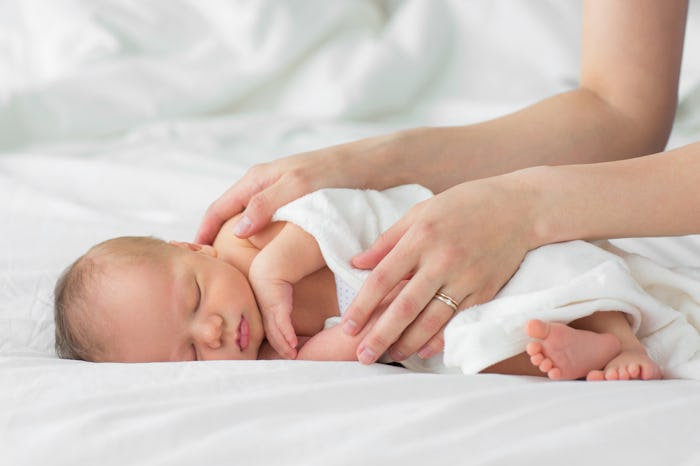Life

When Your Baby Can Sleep On Their Side, According To Experts
As a new parent it's impossible to read any article on safe sleeping practices without being reminded that you have to put your baby on their back. Most likely people from the "older generation" (read: certain in-laws) might be tempting you with stories about how everyone used to put babies on their stomachs to sleep and no harm was done. You know that's not an option no matter how nice that sounds, but does a happy medium exist? More specifically, when can baby start sleeping on their side? You know, so at least you can mark your calendar for that banner day and stop worrying about your baby's sleep position.
As reported on the American Academy of Pediatric's (AAP) website, the AAP's 2016 revised guidelines on infant sleep safety state that all babies up to 1 year old should be placed to sleep on their backs for naps and at night. The reason, of course, is that back sleeping drastically reduces the risk of Sudden Infant Death Syndrome (SIDS) – the cause of up to 3,500 infant deaths each year, as noted on the site Healthy Children. Some parents think side sleeping is the "safer" option to tummy sleeping, but, well, they're wrong. As the website Healthy Children notes, the side position is especially problematic because it is an easy position from which babies can roll onto their stomachs anyway.
It is even more dangerous to place an infant to sleep on their side if you use a sleep positioner, such as a wedge or rolled up blanket. The AAP includes in its revised guidelines on safe sleep practices that parents and caregivers stay away from sleep positioners or props of any kind when placing infants to sleep. The Center for Disease Control and Prevention (CDC) released a report in 2012 that stated there were 13 cases of infant deaths related to infant sleep positioners, ranging in age from 21 days to 4 months. So if you see any advertisements for devices that will help your baby sleep better in their crib, ask your pediatrician first or avoid them altogether.
But what if your baby rolls over onto their side in the middle of the night, or during a nap, on their own? Are you supposed to keep vigil by their beds so you can correct their sleeping position and then risk waking them up? As always, check with your health care provider, but The Mayo Clinic states on its website that once your baby is able to roll over both ways without help, you can leave them in that side position. Even better, The Mayo Clinic states, you no longer have place your baby on their back to sleep after they can roll back to tummy. The site Healthy Children concurs, saying, "If your baby is comfortable rolling both ways (back to tummy, tummy to back), then you do not have to return your baby to the back."
There are, as The Baby Sleep Site points out, some safety precautions to take once your baby starts rolling over in their sleep. For starts, parents should take off that swaddle as you don't want your baby getting all tangled (and the swaddle can therefore become a suffocation risk). Also, make sure there are no other suffocation risks in the crib, including pillows, bumpers, toys, or loose blankets.
So your final answer on when a healthy baby can start sleeping on their side is either after they do their cake smash at their first birthday party, or after they start rolling comfortably and independently from tummy to back and back to tummy. In the meantime, refer your relentless in-laws to the SIDS statistics, and even that horrible CDC report, the next time they try to nudge you towards tummy or side-sleeping.